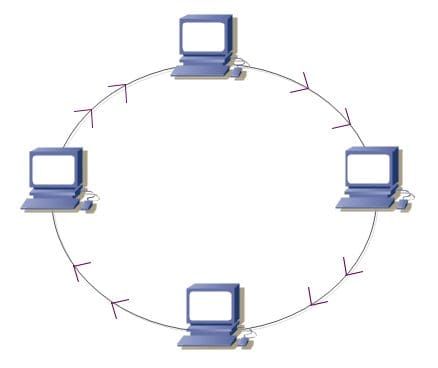In any computer network, you need to decide on a topology. A network topology is the physical architecture of how the computers connect to each other. A classic network topology is the Ring Topology. In this structure, all devices in the network are connected in a single ring. All network traffic goes in a single direction around the loop. This means that each device has two connections to the network, one that receives data and one that transmits data.

Benefits
The ring topology is relatively easy to set up, at least on small scales. For example, if you think about connecting each computer in an office to the one next to it this would be relatively simple to do. The concept gets even easier to implement with rack servers. The difficulty comes when dealing with networks in different rooms, floors, or buildings where it can be more difficult to run the cables.
In ring topology networks, there is no need for collision detection or collision avoidance technologies, as each device already knows if it is transmitting data or not, and therefore if it can or can’t transmit more. No central server or router is needed to manage the connectivity between devices.
Drawbacks
Because network traffic only flows in one direction, all traffic must go all the way around the loop once. While the intended recipient could identify the message as meant for it and not transmit it on, if it did so there would be no way for the sender to verify that the message had been received or not. This wastes bandwidth, which may cause issues in heavily loaded networks.
Any single device failure can bring down the entire loop. If every message needs to complete a full loop, if there’s a break anywhere in the loop all messages will appear to fail. Technically, some messages may have made it to their intended recipient, if they were earlier in the loop than the failure, however, the sender has no way to know this. This issue can be mostly resolved with a bi-directional loop or counter-rotating ring topology variant discussed below.
Making any adjustment to the ring causes a disruption, temporarily breaking the whole ring. As each device only has two connections, adding a new device or removing an old one, causes a break in the network, shutting down the whole ring, until the connection is restored.
Unfortunately, this also means that all devices need to remain powered on. If a computer is turned off, its network card no longer transmits messages. This would break the ring, making ring topologies unsuitable for networks that don’t have near-perfect up times. The whole ring failing when a single link fails also makes them unsuitable for remote management, as any remote access would generally rely on the broken loop.
Communication latency is directly proportional to the number of devices in the loop. Each hop that a network packet needs to make, increases the time it takes to get to its destination.
Variants
A bi-directional loop or counter-rotating ring topology is a variant of the ring topology that has a secondary loop that transmits network traffic the other way around the loop. Typically, this secondary loop is not used unless the main loop is broken. Once a break is detected, the nearest working device to the break routes any traffic back around the loop the other way, essentially making a “C” shaped loop.
Theoretically, a secondary loop could also be used to provide extra bandwidth, though this generally isn’t done. While a second loop could be provided by connecting another pair of wires to each device, this also typically isn’t done, as it doubles the necessary infrastructure for the ring. Instead, bi-directional communication over a single cable is enabled by utilising full duplex communication. This helps to provide fault tolerance in a loop but doesn’t address complexities of scale or the latency issue.
A token ring topology may be easy to confuse with ring topology, however, they are very different. Despite the name, a token ring network actually uses a star topology at the physical connectivity layer.
Conclusion
Ring topology is a computer network architecture that places all devices in a single ring. All network traffic is transmitted in one direction around the ring making it simple to set up small, local networks. The topology struggles at scale though and each device in the network essentially acts as a single point of failure that can bring the whole network down. For these reasons, ring topologies are now very rarely used, if at all. Star topology networks tend to be used for endpoints, while backend networks use a mesh topology.



